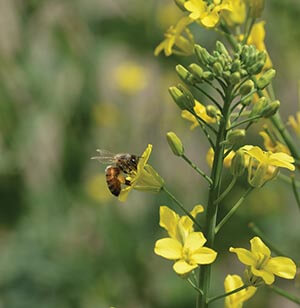
Canola yields a lucrative honey crop. Is there a downside, or is everything golden?
In July, much of the Canadian prairie is an endless sea of yellow flowers, broken only by roads every mile or two and the occasional clump of trees. By now, those fields are probably browning and farmers are likely busy harvesting their mature crop. Every two to four years, the field will be seeded again in the spring, bloom through July, and be harvested at the end of the summer, with crops like wheat or soybean planted in the intervening years. And the cycle of canola farming goes on.
Canola is a variety of rapeseed that was developed by scientists at Agriculture Canada and the University of Manitoba, Dr. Keith Downey and Dr. Baldur Stefansson, in the 1970s. Rapeseed is crushed to extract the oil, and Downey and Stefansson wanted to produce a variety that had lower amounts of erucic acid, which was predicted to be harmful to human health. Indeed, the name “canola” is derived from the phrase “Canadian oil, low acid.”
Canada produces around 20 million tonnes of crude canola each year — used mostly for oil and animal feed — which is grown on a land area approximately equivalent to the entire state of South Carolina. The Canadian canola industry is about ten times bigger, in terms of production, than the U.S. industry. This translates into massive honey yields, with average production in the prairies ranging from around 126 lbs./hive in Alberta up to, and sometimes surpassing, 200 lbs./hive in Saskatchewan.
“My honey farm will bring in roughly 275,000 pounds of honey annually, 75-85% of it being canola,” says Ian Steppler, owner of Steppler Farms in Manitoba, Canada. Steppler has been keeping honey bees and growing canola for twenty years — the duration of his farming career. “My hives explode in growth as the canola starts to flower,” he says, explaining that it probably has something to do with the high quality of canola pollen.
“Canola has a high nectar yield and the pollen is abundant and nutritious,” says Dr. Shelley Hoover, president of the Canadian Association of Professional Apiculturists and apiculture researcher for the Alberta government. “Bees do really well on it.”
Canola pollen is around 24-26% crude protein — approximately double that of buckwheat, fireweed, and sunflower pollen. Unlike flowers such as lavender and thistle, it also contains all the essential amino acids, which are the components of proteins that bees can’t make themselves and must acquire from their diet. Steppler says that this pollen is “very precious,” especially with forage diversity and abundance disappearing in the agricultural landscape.
To coat the seed or not to coat the seed?
Canola is widely considered an excellent crop for honey bees, despite controversy over neonicotinoid seed coatings. Today, most canola seed in North America is coated with the neonicotinoids clothianidin or thiamethoxam, and it is difficult to buy untreated seed.
“What I hear from beekeepers is that they would far prefer this kind of seed treatment to any insecticidal spray,” says Hoover. “The levels of these insecticides that we detect tend to be even lower than in Europe, often at the limits of detection by our instruments.”
In Europe, before these neonicotinoid insecticides were banned, Dr. Ben Woodcock — an ecological entomologist at the U.K. Center for Ecology and Hydrology — and his colleagues conducted a large-scale field study to investigate health effects of seed treatment on three different bee species.1 The researchers worked in three different countries, Hungary, Germany, and the U.K., and tracked numerous health metrics for honey bees, bumble bees, and mason bees placed in treated and untreated oilseed rape fields.
The results, published in Science three years ago, showed that the effect of seed treatments varied substantially between countries. In Germany, the only significant effects they identified were actually beneficial, whereas in Hungary, it was harmful, and in the U.K., they found both beneficial and harmful effects.
The take-home message is that the seed treatments were not obviously good or bad, in terms of direct impacts on bee health outcomes. In Canada, Dr. Chris Cutler and Dr. Cynthia Scott-Dupree also investigated effects of clothianidin seed-treated canola on honey bees and found no significant long-term damage.2 But this also does not let systemic seed-treatments off the hook: There are other crops, like clothianidin-treated corn, where negative effects on honey bee health have been clearly demonstrated.3
But what we do know is that seed treatments substantially reduce canola growers’ need to spray their crops with insecticides. And if they do need to spray, modern equipment gives farmers more ….


